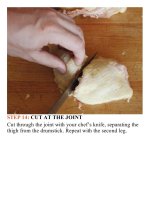The food lab better home cooking through science ( PDFDrive ) 706
Bạn đang xem bản rút gọn của tài liệu. Xem và tải ngay bản đầy đủ của tài liệu tại đây (133.92 KB, 2 trang )
difference in flavor: the broth-brined chicken still had the
same hallmarks of a regular brined bird (juicy/wet texture,
blandflavor).Whattheheck’sgoingon?
There are two principles at work here. The first is that
while to the naked eye broth is a pure liquid, in reality, a
brothconsistsofwaterwithavastarrayofdissolvedsolids
initthatcontributeflavor.Mostoftheseflavorfulmolecules
are organic compounds that are relatively large in size—on
a molecular scale, that is—while salt molecules are quite
small. So, while salt can easily pass across the
semipermeablemembranesthatmakeupthecellsinanimal
tissue,largermoleculescannot.†
Additionally,there’saneffectcalled“saltingout,”which
occursinwater-basedsolutionscontainingbothproteinsand
salt. Water molecules are attracted to salt ions and will
selectively interact with them. The poor proteins,
meanwhile,areleftwithonlyeachotherandendupforming
largeaggregategroupsthatmakeitevenharderforthemto
getintothemeat.Whenthesaltbreaksdownmusclefibers
sufficientlytoallowtheuptakeofwater,plentyofwaterand
saltgetintothemeat,butverylittleproteindoes.
The result? Unless you are using an extraconcentrated
homemade stock, the amount of flavorful compounds that
make it inside your chicken or turkey will be very, very
limited.Giventheamountofstockyou’dneedtomakethis
concentratedbroth,itdoesn’tseemlikeawisemove.
WhatDoesThisAllMean?
Well, let me end the way I started: I don’t brine my birds,
becauseIlikemybirdstotastelikebirds,notlikewatered-
down birds. Salting the meat is nearly as effective at
preventing moisture loss, and the flavor gains are
noticeable.Want to know the truth? Even advanced salting
is not a necessary first step. I see it more as a safeguard
against overcooking. It provides a little buffer in case you
accidentally let that bird sit in the oven for an extra 15
minutes.As long as you are very careful about monitoring
yourbird,there’snoreasontosaltitinadvance.
That said, it doesn’t hurt to take precautions and let
deliciousness, merriment, and family bonding ensue. You
may not all be able to agree on whether the cranberries
belonginthestuffingorontheside,butatleastyoucanall
agreethatthisisonedarntastybird.
HOWTODRY-BRINEABIRD
S
alting poultry under its skin and letting it stand
foraperiodof24to48hoursintherefrigeratorhas
much the same effect as brining. At first the salt
drawsliquidoutofthemeat(andthistimeitreallyis
through osmosis), but then it dissolves in this
extracted liquid, forming a concentrated bird-juice
brinerightonthesurfaceofthebirdthatthengoes
toworkatdissolvingmusclefibersthesamewayas
aregularbrine.Eventually,asthemusclefibersget
more and more relaxed, the liquid is reabsorbed.
Overthecourseofanightortwo,thesaltysolution









